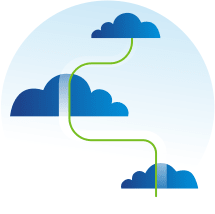Tag: Virtualization
Setting Up KVM and Virtualization on Ubuntu
What is Virtualization?
In computing, virtualization is the method of creating a software-based instance of a specific tool that is typically physical. The kinds of tools one can virtualize are:
What is VMware vSphere?
Virtualization is the go-to solution for organizations looking to maximize the performance of their available resources without increasing the associated costs. The ability to create and run one or more virtual instances of software applications or hardware-like servers and networking devices increases IT departments’ flexibility and ability to scale infrastructure based on business needs.
How to Install KVM on CentOS 8
Different business and development workloads call for more versatility in your environment. Virtualization provides an option for creating virtual environments to host, test, and develop your mission-critical projects.
What is Desktop-as-a-Service?

Introduction
As firms advance towards a more modern infrastructure, the Desktop-as-a-Service (DaaS) model is becoming an increasingly popular cloud-based system. Desktop-as-a-Service is a multi-tenant, cloud computing solution in which a service provider furnishes a virtual desktop to an end-user over the internet. A provider typically manages the infrastructure, including the security updates, available desktop applications, data storage, and backups. In specific instances, DaaS users manage these services individually. According to Gartner via Workspot:
What are the Five Criteria Of a Cloud Platform?
Cloud computing is a model for empowering users to access a useful, network-accessible, shared pool of resources that allows for quick changes to settings and configurations with minimal intervention from a service provider in an easy-to-maneuver self-service management interface.
How to Store Secrets in Kubernetes
What is a Secret?
A Kubernetes Secret is an object that enables us to store and manage sensitive information. A Secret can contain data like SSH keys, OAuth data, or other user authentication information like passwords. It is typically stored within a cluster in a manner native to Kubernetes. Using a Secret object provides more granular control over how highly sensitive data is used. It also lowers the risk of data exposure to unauthorized parties.
How to Install and Configure KubeKey
What is KubeKey?

KubeKey is the newest Kubernetes installer for KubeSphere. KubeSphere is a distributed OS management system for cloud-native applications using Kubernetes as its kernel. It provides a plug-and-play structure for seamless integration of many third-party applications. It is somewhat similar in nature to MiniKube for installing Kubernetes.
Why Choose a VMware Cloud?

If you have been in the hosting industry for some time, you most likely had to upgrade your hosting package or resize your server at some point. As your business grows, so do the resources needed to run that business. Over the years, someone has most likely recommended a private cloud solution to you. You probably asked yourself why you would need a more expensive private solution like VMware cloud when you have a powerful VPS server or Dedicated server that is perfectly capable of handling your existing traffic.
SaaS vs PaaS vs IaaS: What’s The Difference and How Do You Choose?
Moving an Internet business to a cloud platform has flourished and gained prominence in the current industrial climate. Three main types of cloud computing service models are Software-as-a-Service (SaaS), Platform-as-a-Service (PaaS), and Infrastructure-as-a-Service (IaaS).
Using Telepresence to Improve Microservice Development

What is Telepresence?
Initially developed by Datawire, Telepresence is a new open-source tool supported by the CNCF (Cloud Native Computing Foundation). It allows developers to run local software while connected to a remote Kubernetes cluster. The application uses a two-way network proxy to simulate TCP connections, environmental variables, and other volumes of services as local processes. This link allows for remote work to be accomplished while seemingly local to the cluster via the proxied connection.
Our Sales and Support teams are available 24 hours by phone or e-mail to assist.

